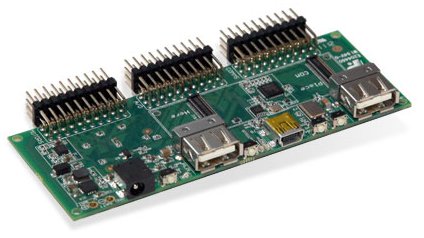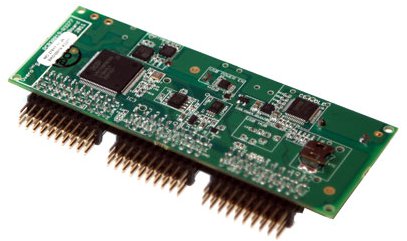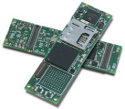Overo modules control new robot board
Jul 21, 2011 — by Eric Brown — from the LinuxDevices Archive — 11 viewsGumstix announced a controller board designed to integrate its Cortex-A8-based, 1GHz Overo computer-on-module (COM) into robots, for Linux-based planning and other higher-end functions. The RoboVero board includes NXP's Cortex-M3-based LPC1769 processor clocked to 120MHz plus buttons, LEDs, sensors, 3-axis controls, and interfaces ranging from CAN to I2C.
The RoboVero is said to be the first in a new line of robotic and mechatronic controllers from Gumstix, which is well-established in the robotics and hobbyist communities via its Linux-based Verdex (and more recently its Overo COMs). The 0.7 x 2.3 x 0.2-inch (17 x 58 x 4.2mm) Overo line, which is based on Texas Instruments (TI) OMAP35xx system on chips (SoCs), is sufficiently independent as to border on being a single board computer (see farther below for background).
 RoboVero
RoboVero
Gumstix supports the RoboVero with a variety of software packages for programming and running the device. Tools include a USB console with a command-line interface to a sample set of libraries for the LPC1769 from NXP Semiconductors, says Gumstix. Also supplied is the Python Client Library and Arduino Compatibility Layer.

RoboVero, rear view
The RoboVero controller weighs 1.13 ounces (32 grams), and measures approximately 4.65 x 2.64 inches (118 x 67mm), says Gumstix. The board is built around NXP's Cortex-M3-based LPC1769 processor. The chip clocks to 120MHz and offers 512KB flash, 64KB SRAM, ADC and DAC, as well as a variety of I/O, including USB 2.0 host/device/On-The-Go.
The RoboVero's HubCommander interface uses USB to enable an external host to commandeer the onboard USB hub, as well as devices including:
- Cortex-M3 JTAG Cortex-M3 USB device
- 2 x USB standard A jacks
- console for the onboard Overo (if present)
The RoboVero also supplies a 3-axes accelerometer, magnetometer, and gyroscope for linear, magnetic, and rotational measurements, says Gumstix.
Three 3×10 headers control motor, AD, and communication tasks, respectively. The motor header supplies seven lines each for power and return at motor voltage, as well as six PWM lines at 3.3V, and 10 motor control lines at 3.3V, says Gumstix. The AD header handles a dozen A/D (analog/digital) lines, including A/D reference and power lines, as well as an SPI bus and seven GPIO.
The communication header, meanwhile, carries the bulk of the I/O. This is said to include:
- 2 x two-wire serial ports
- four-wire serial port
- I2C bus
- SPI bus
- CAN bus
- 3 x GPIO
- power lines
Overo background
The Overo was launched in 2008 as a more powerful follow-on to the Verdex modules. All the Overo modules incorporate either the low-end (OMAP3503) or high-end (OMAP3530) versions of TI's Cortex-A8-based OMAP35x SoCs.
The Overo Earth and Overo Air (which adds Wi-Fi) both run on a 600MHz OMAP3503. The Overo Water (which adds OpenGL graphics), and Overo Fire (with OpenGL and Wi-Fi) originally ran on a 600MHz OMAP3530, but now use the faster 720MHz version of the SoC. This processor is now said to be available at up to 1GHz clock rates.
 In December of last year, the company added an Overo Tide module (pictured), which doubled RAM to 512MB. All the Overo modules are supported by Gumstix with a variety of expansion boards and Linux-ready development kits.
In December of last year, the company added an Overo Tide module (pictured), which doubled RAM to 512MB. All the Overo modules are supported by Gumstix with a variety of expansion boards and Linux-ready development kits.
Options available for the Overo series include a touchscreen LCD, HDMI-over-DVI, accelerometer, USB high speed and OTG, and 10/100 Ethernet (including dual Ethernet port support). Wireless options are said to include 802.11b/g, Bluetooth, and GPS. Additional options are said to include NiMH battery power, battery backup, stereo audio, cluster computing, and camera functions.
Stated W. Gordon Kruberg, CEO of Gumstix Inc., "By launching the RoboVero, Gumstix brings fast and affordable processing to low-level control systems that can be tightly coupled to Linux supervisors, and a wealth of advanced open-source software."
Availability
The RoboVero is available now for $99 in single quantities, without an Overo module or power supply. Online sales and more information may be found at the Gumstix RoboVero product page.
This article was originally published on LinuxDevices.com and has been donated to the open source community by QuinStreet Inc. Please visit LinuxToday.com for up-to-date news and articles about Linux and open source.